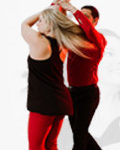We usually think that dancing slow is only necessary when we are first learning a pattern. But, dancing slow is also a great way to practice your control. In this drill, we’ll look at how you can use slow dancing to your advantage beyond the initial learning experience.
Dance to slow music to develop control
West coast swing, like all dances, requires you to dance between the beats of music in order to create a smooth, fluid, and controlled movement. By dancing to slow tempos, you create the time to see what is happening between the beats so that you can develop your control over those split-second moments.
This principle is useful for almost any movement in west coast swing. In fact, the only movements that this isn’t true for are ballistic movements (in which you have maximum muscle contraction within a short burst of time, like when you leap or throw a punch). Ballistic movements are pretty rare within west coast swing, so you should be able to apply this principle almost everywhere.
The flip side of that principle is that, if you are unable to do a non-ballistic movement slowly, you are hiding something. There is some fundamental weakness in the movement that you have to cover up with a ballistic movement. It might be a lack of muscle control through a transition, a limitation in your range of motion, or an inability to sustain the power generated in the movement. Whatever the reason, forcing yourself to dance slowly gives you the opportunity to work through these limitations.
The Drill: To develop your control, practice dancing to really slow songs. Push/whip music works great for this, as does really slow blues—as in 60 beats per minute slow. Some great choices are Blues Power by Albert King, Love & the Blues by Brother Yusef, and Can’t Stop Thinking About You by Martin Sexton.
You can do this drill with a partner or by yourself. You will rush through your movements at first, so become comfortable with stopping, starting over, and really concentrating on the beat. Keeping the rolling count in your head (&a1 &a2…) helps.
It will take lots of practice to measure your movement so that you don’t arrive early, If you are frozen in any position, or if you find yourself waiting for the music to catch up, you went too fast!
For beginning dancers, focus on filling the time with the rolling action of your feet. For more advanced dancers, think about filling the time with your body flight and your styling.



 Brian & Megan
Brian & Megan